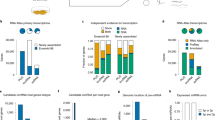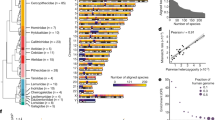Abstract
MicroRNAs are noncoding RNAs of ∼22 nucleotides that suppress translation of target genes by binding to their mRNA and thus have a central role in gene regulation in health and disease1,2,3,4,5. To date, 222 human microRNAs have been identified6, 86 by random cloning and sequencing, 43 by computational approaches and the rest as putative microRNAs homologous to microRNAs in other species. To prove our hypothesis that the total number of microRNAs may be much larger and that several have emerged only in primates, we developed an integrative approach combining bioinformatic predictions with microarray analysis and sequence-directed cloning. Here we report the use of this approach to clone and sequence 89 new human microRNAs (nearly doubling the current number of sequenced human microRNAs), 53 of which are not conserved beyond primates. These findings suggest that the total number of human microRNAs is at least 800.
This is a preview of subscription content, access via your institution
Access options
Subscribe to this journal
Receive 12 print issues and online access
$209.00 per year
only $17.42 per issue
Buy this article
- Purchase on Springer Link
- Instant access to full article PDF
Prices may be subject to local taxes which are calculated during checkout




Similar content being viewed by others
Accession codes
References
Ambros, V., Lee, R.C., Lavanway, A., Williams, P.T. & Jewell, D. MicroRNAs and other tiny endogenous RNAs in C. elegans . Curr. Biol. 13, 807–818 (2003).
Bartel, D.P. MicroRNAs: genomics, biogenesis, mechanism, and function. Cell 116, 281–297 (2004).
Johnston, R.J. & Hobert, O. A microRNA controlling left/right neuronal asymmetry in Caenorhabditis elegans . Nature 426, 845–849 (2003).
Lim, L.P., Glasner, M.E., Yekta, S., Burge, C.B. & Bartel, D.P. Vertebrate microRNA genes. Science 299, 1540 (2003).
Poy, M.N. et al. A pancreatic islet-specific microRNA regulates insulin secretion. Nature 432, 226–230 (2004).
Griffiths-Jones, S. The microRNA registry. Nucleic Acids Res. 32, D109–D111 (2004).
Barad, O. et al. MicroRNA expression detected by oligonucleotide microarrays: System establishment and expression profiling in human tissues. Genome Res. 14, 2486–2494 (2004).
Lim, L.P. et al. The microRNAs of Caenorhabditis elegans . Genes Dev. 17, 991–1008 (2003).
Berezikov, E. et al. Phylogenetic shadowing and computational identification of human microRNA genes. Cell 120, 21–24 (2005).
Xie, X. et al. Systematic discovery of regulatory motifs in human promoters and 3′ UTRs by comparison of several mammals. Nature 434, 338–345 (2005).
Suh, M. et al. Human embryonic stem cells express a unique set of microRNAs. Dev. Biol. 270, 488–498 (2004).
Houbaviy, H.B., Murray, M.F. & Sharp, P.A. Embryonic stem cell-specific microRNAs. Dev. Cell 5, 351–358 (2003).
Bentwich, I. A postulated role for microRNA in cellular differentiation. FASEB J. 19, 875–879 (2005).
Hofacker, I.L. Vienna RNA secondary structure server. Nucleic Acids Res. 31, 3429–3431 (2003).
Siepel, A. & Haussler, D. Combining phylogenetic and hidden Markov models in biosequence analysis. J. Comput. Biol. 11, 413–428 (2004).
Schwartz, S. et al. Human-mouse alignments with BLASTZ. Genome Res. 13, 103–107 (2003).
Elbashir, S.M., Lendeckel, W. & Tuschl, T. RNA interference is mediated by 21- and 22-nucleotide RNAs. Genes Dev. 15, 188–200 (2001).
Acknowledgements
We thank the members of the Rosetta Genomics team for their dedication and contribution.
Author information
Authors and Affiliations
Corresponding author
Ethics declarations
Competing interests
The authors are employed by and own shares or options in Rosetta Genomics Ltd., a company that is involved in discovery and commercialization of microRNA.
Supplementary information
Supplementary Fig. 1
Expression profiles of novel validated microRNAs (I). (PDF 99 kb)
Supplementary Fig. 2
Expression profiles of novel validated microRNAs (II). (PDF 441 kb)
Supplementary Table 1
Novel validated microRNAs. (PDF 88 kb)
Supplementary Table 2
Microarray results for novel validated and known microRNAs. (PDF 59 kb)
Rights and permissions
About this article
Cite this article
Bentwich, I., Avniel, A., Karov, Y. et al. Identification of hundreds of conserved and nonconserved human microRNAs. Nat Genet 37, 766–770 (2005). https://doi.org/10.1038/ng1590
Received:
Accepted:
Published:
Issue Date:
DOI: https://doi.org/10.1038/ng1590
This article is cited by
-
Spinal Cord Injury: From MicroRNAs to Exosomal MicroRNAs
Molecular Neurobiology (2024)
-
MicroRNA-155 targets SOCS1 to inhibit osteoclast differentiation during orthodontic tooth movement
BMC Oral Health (2023)
-
Modulation mütterlicher Immunzellen durch plazentare extrazelluläre Vesikel und microRNA
Gynäkologische Endokrinologie (2023)
-
Integrated multiomics analysis of chromosome 19 miRNA cluster in bladder cancer
Functional & Integrative Genomics (2023)
-
Maternal obesity alters methylation level of cytosine in CpG island for epigenetic inheritance in fetal umbilical cord blood
Human Genomics (2022)



